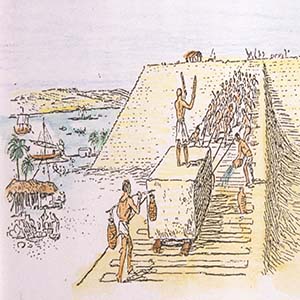Using AI to control energy for indoor agriculture
30 September 2024
Published online 8 August 2023
Study reveals a nutritious diet could have contributed to the incredible feat of the Giza workforce.

A plethora of studies have been published, as well as theories on how they were constructed, as researchers try to unravel the pyramids’ mysteries.
Good food
There are some theories that the pyramids were constructed by slaves or forced labourers, but a new study undermines that idea, proposing that the builders were skilled workers who maintained a nutritious, high-quality and plentiful diet.
Using fossil evidence, the researchers, at the European Centre Research and Teaching in Geosciences (CEREGE), Aix-Marseille University, France, found the workers consumed significant quantities of animal protein and fruit.
Palynological and other fossil evidence unearthed from the Giza Plateau reveals that the builders’ diet comprised meat, fruit, barley and wheat, says the study’s principal author, Hader Sheisha. The work finds that “transhumance tribes, originally from the Eastern Sahara, settled along the Giza Plateau 5,200 years ago, primarily engaging in herding and, more sporadically, agriculture. Giza was transformed into a pastoral landscape, with the development of large swaths of the floodplain, providing societies with continual access to livestock produce (e.g. proteins, milk, meat and wool).”
“Palaeoecological data reveal that the initial complex societies at Giza were deeply rooted in transhumance, pastoralism and animal husbandry,” the study reports. “These activities played a fundamental role in establishing the foundations of a robust and sustainable food system, while also serving as a crucial logistical support for the subsequent construction of the monumental structures that celebrated the grandeur of pharaonic Egypt.”
In 2019, Sheisha joined the GIZAPORT project, which is focused on the pyramids complex and investigates the climate landscape of ancient Giza, and how the human activity dynamics developed in it, with a special emphasis on agriculture and navigation.
As part of the GIZAPORT project, two separate archeological missions were carried out in the region. The first collected samples of sediments at an average depth of 14 meters from the present-day El-Lebbini Canal, which the researchers thought was dug in the place of an ancient waterway.
The second mission obtained sedimental samples from the floodplain, at a depth of up to 20 metres, in an attempt to get a fuller picture of the history of human colonization of the Giza Plateau.
Khufu branch of the Nile
Before the pyramids were built, Giza was swamp land and inhospitable to human settlement. It was only when an ancient, now defunct, branch of the Nile brought life to the region, that Giza was transformed into a habitable region.
Speaking to Nature Middle East, Sheisha described her analysis of Nile river sediments and palaeobotanical samples, through which she had previously revealed evidence of an ancient Nile branch and navigable stream, which she called the “Khufu branch”.
Having made this discovery, Sheisha pursued further answers. Did the Giza Plateau serve only as a port and construction site of the pyramids? Or was it already inhabited by farmers, especially given that agriculture, according to Sheisha, had been deep-rooted in Egypt by the time the pyramids were built?
And if Giza was a residential area, Sheisha wondered, what did its inhabitants eat?
Vast difference
During the early Holocene, some 8,000 years ago, Giza was submerged in water, owing to the then extremely high sedimentation rate of the Nile River, and the numerous interconnected water bodies in the region.
But 5,500 years ago, Giza started to dry up, and people began to flock to the region. During the time of Upper and Lower Egypt unification and the Early Dynastic period, Giza was more of a large, ill-drained, water-logged pastoral land, according to Sheisha.
With the inception of the Old Kingdom, Giza developed into a fairly dry region, and began to accommodate human communities who practiced herding in open pastures, while farming practices started to emerge on well-drained islands.
Previous analysis of the mummified plant remains found in the pots excavated from tombs, as well as evidence derived from temple drawings and writing, suggest that barley, wheat, beans, lentils, legumes and vegetables were all important ingredients for ancient Egyptians. They also ate fish, pork, fruit and honey. Poultry and olives weren’t introduced until the Romans and Ptolemies entered Egypt.
Sheisha and her colleagues analysed remains of coprophilous fungi, a group that grow on animal dung and skin. The researchers also studied another group of fungi that typically grow in degraded land, signaling a grazing activity, in addition to remains of plants growing in places where livestock herds are grazed.
Evolution of Giza
The new study challenge existing theories on the history and evolution of Giza and its surrounding areas, Sheisha says.
“Studies of Giza during the pyramid construction era are exclusively focused on Giza necropolis and burials, ultimately backing up the predominant narrative that Giza was, at best, a port with a village attached to it, where people cultivated some crops,” she told Nature Middle East.
“We know that Egypt’s economy during the Old Kingdom, when the pyramids were built, was largely agriculture-based,” Sheisha adds. “Surprisingly, though, the foregoing notion of ancient Giza seems to be a simplified conception of a more complex reality. It is true that palynological evidence establishes that there is pollen of plants such as wheat, barley and beans from the pyramid-building period, that lasted for about 23 years. Nevertheless, the proportion of those cultivated plants was less than 10% of the region’s plant formation (3% wheat and barley, and around 6% cultivated legumes such as beans), the rest being wild plants that grew along the banks of the Nile River channels (like papyrus and chenille plant), while grazing grass made up over 60% of the region’s vegetation. All of which suggests that the area was mostly a pasture rather than a farming land.”
doi:10.1038/nmiddleeast.2023.123
Stay connected: